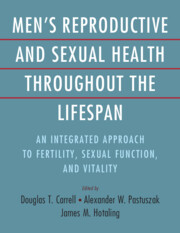 Men's Reproductive and Sexual Health Throughout the Lifespan
Men's Reproductive and Sexual Health Throughout the Lifespan from Section 3 - Clinical Evaluation and Treatment of Male Infertility
Published online by Cambridge University Press: 06 December 2023
Male factor infertility contributes to roughly 50% of the causes of infertility among couples. Advancements in the diagnostic field of reproduction allowed for the recognition of various etiologies for male factor infertility. Various pretesticular, testicular, and posttesticular etiologies have been identified and are believed to arise from genetic causes in 15–30% of cases. While a number of laboratory tests are available, the indication of genetic testing relies primarily on the findings in the history, physical examination, and semen analysis. Men with suspicion of nonobstructive azoospermia and those with idiopathic severe oligozoospermia are investigated with karyotype and Y-chromosome microdeletion assays. Analysis of the cystic fibrosis transmembrane conductance regulator (CFTR) gene is reserved for patients with obstructive azoospermia secondary to a unilateral or bilateral complete absence of the vas deference. In addition to the more commonly adopted tests, the genetic evaluation may have a role in patients with congenital hypogonadotropic hypogonadism and androgen insensitivity syndrome. Genetic testing of male infertility is a rapidly evolving field in andrology. Epigenetics, next-generation DNA sequencing, and microarray-based technologies represent some of the promising development in the area and may further expand the clinical utilization of genetic evaluation.
To save this book to your Kindle, first ensure no-reply@cambridge.org is added to your Approved Personal Document E-mail List under your Personal Document Settings on the Manage Your Content and Devices page of your Amazon account. Then enter the ‘name’ part of your Kindle email address below. Find out more about saving to your Kindle.
Note you can select to save to either the @free.kindle.com or @kindle.com variations. ‘@free.kindle.com’ emails are free but can only be saved to your device when it is connected to wi-fi. ‘@kindle.com’ emails can be delivered even when you are not connected to wi-fi, but note that service fees apply.
Find out more about the Kindle Personal Document Service.
To save content items to your account, please confirm that you agree to abide by our usage policies. If this is the first time you use this feature, you will be asked to authorise Cambridge Core to connect with your account. Find out more about saving content to Dropbox.
To save content items to your account, please confirm that you agree to abide by our usage policies. If this is the first time you use this feature, you will be asked to authorise Cambridge Core to connect with your account. Find out more about saving content to Google Drive.